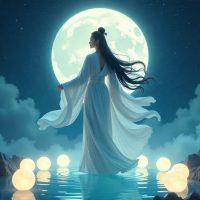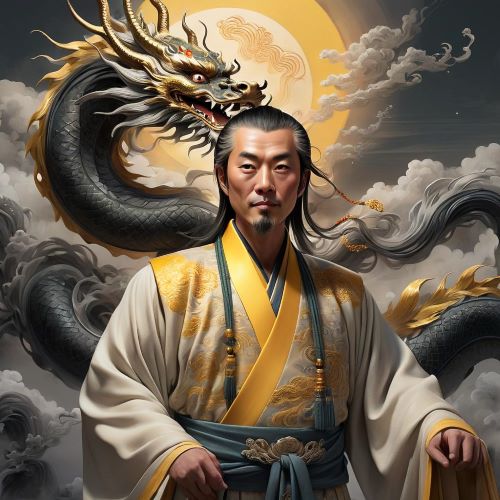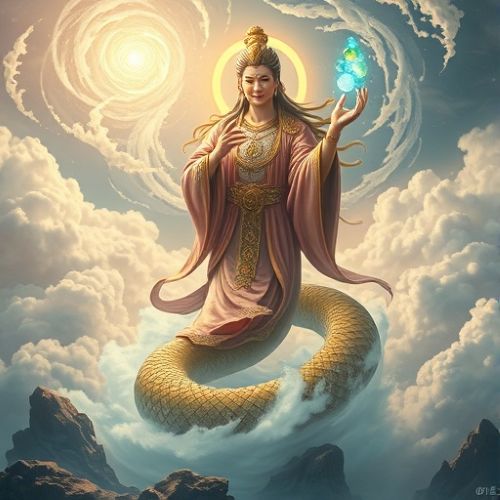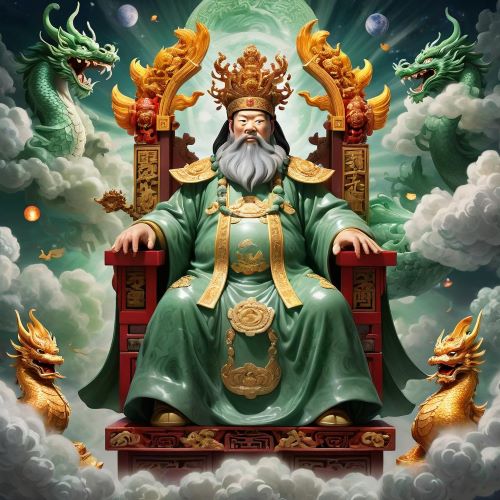Chang Xi : The Lunar Mother Goddess of Twelve Moons
Listen
At a glance
| Description | |
|---|---|
| Origin | Chinese Mythology |
| Classification | Gods |
| Family Members | Di Jun (Husband) |
| Region | China |
| Associated With | 12 Moons |
Chang Xi
Introduction
In the luminous world of Chinese mythology, Chang Xi (常羲) emerges as one of the earliest and most profound lunar goddesses. Her story, preserved in the ancient text Classic of Mountains and Seas (Shan Hai Jing), portrays her as the wife of Di Jun, the celestial emperor, and the mother of twelve moons. While she is often overshadowed by the more famous moon goddess Chang’e, Chang Xi’s myth predates hers and reflects the earliest Chinese cosmological understanding of time, femininity, and the cyclical nature of the universe. Her narrative weaves together divine motherhood, cosmic rhythm, and the serene glow of the lunar realm.
Physical Traits
Chang Xi’s divine beauty mirrors the soft, silvery light of the moon she governs. Classical and modern interpretations describe her as an ethereal woman with long flowing black hair, pale luminous skin, and robes that shimmer like moonlight. Artists often depict her surrounded by celestial waters or bathing her twelve daughters—the twelve moons—in a sacred pool, a symbol of renewal and purification. These images reflect her role as the eternal nurturer of lunar radiance and the embodiment of yin energy, representing gentleness, reflection, and the subtle strength of the feminine.
Her serene expression and calm posture symbolize tranquility and introspection, qualities associated with the moon’s steady presence in the sky. Occasionally, Chang Xi is shown accompanied by the jade rabbit or toad, both creatures with deep lunar symbolism in Chinese folklore.
Family
Chang Xi’s divine family represents the celestial balance of the cosmos. She is married to Di Jun (帝俊), the god of the Eastern Sky and one of the most prominent deities in Chinese mythology. Di Jun’s first wife, Xi He, gave birth to the ten suns, while Chang Xi bore twelve moons. Together, they maintain the equilibrium between day and night, light and darkness, and yang and yin—two opposing yet harmonious cosmic forces.
Chang Xi’s twelve daughters represent the twelve lunar months, their cyclical journey across the heavens marking the passage of time and guiding the agricultural rhythms of ancient China. This celestial family embodies the intricate balance of time and space, symbolizing how the heavens govern the natural and spiritual worlds.
Other names
Chang Xi is also known by the name Chang Yi (常儀) in some historical texts, though her mythological attributes remain the same. The similarity of her name to Chang’e (嫦娥) has caused centuries of confusion, but their stories are distinct. Chang Xi’s tale originates from early Chinese cosmology, while Chang’e’s myth developed later, focusing on immortality and love. Some scholars propose that both figures may have descended from a shared ancient lunar archetype, representing evolving perceptions of the moon’s divinity in Chinese culture. Chang Xi’s name, meaning “Eternal Elegance” or “Constant Grace”, reflects her timeless connection to the moon’s gentle beauty and unending cycles.
Powers and Abilities
As the Goddess of the Moon and Mother of the Twelve Moons, Chang Xi governs the celestial order of night and the rhythm of time. Her divine powers are intertwined with the lunar phases, tides, and fertility cycles. She bathes her twelve moon daughters in a sacred pool, ensuring that their light renews with each phase—an ancient allegory for the waxing and waning of the moon.
Chang Xi also embodies the yin principle, influencing calmness, reflection, and the emotional balance of nature and humankind. Her presence is said to stabilize the tides and guide nocturnal creatures. In spiritual terms, she represents tranquility, wisdom, and cyclical rebirth.
Some traditions believe that she can transform into lunar animals such as the toad or jade rabbit, reinforcing her mystical connection to lunar energy and immortality. As the guardian of night’s gentle glow, she symbolizes feminine strength, serenity, and the perpetual motion of the cosmos.
Modern Day Influence
Though Chang Xi no longer occupies a central place in popular worship, her essence continues to ripple through Chinese folklore, literature, and astrology. Her myth remains integral to understanding the ancient roots of the Chinese lunar calendar, which continues to dictate festivals, agricultural practices, and cultural traditions today.
In contemporary scholarship, Chang Xi’s narrative is often revisited to emphasize the female divine archetypes within early Chinese mythology. She represents a quieter, more cosmic version of femininity—contrasting with Chang’e’s emotional and romanticized persona. Artists and writers exploring ancient cosmology, nature’s cycles, and divine motherhood often draw inspiration from Chang Xi’s story.
Modern interpretations also highlight her as a symbol of balance and renewal, especially in discussions about the natural harmony between the solar and lunar worlds. While rarely featured in mainstream media, her influence lingers in mythological retellings, temple art, and lunar festival symbolism, ensuring that her quiet radiance continues to shine through China’s cultural heritage.
Related Images
Source
Classical Chinese text: The Classic of Mountains and Seas (Shan-hai Jing). (n.d.). Retrieved from ancient sources compiled in translations and academic anthologies.
Mythopedia. (2022). Changxi. Retrieved December 1, 2022, from https://mythopedia.com/changxi
Ancient Chinese Mythology. (n.d.). Changxi - 常羲. Retrieved from https://ancientchinesemythology.blogspot.com
Wikipedia contributors. (2003, November 16). Chang’e. Wikipedia. https://en.wikipedia.org/wiki/Chang%27e
Mythical Encyclopedia. (2023, December 29). Changxi: Overview, Etymology, Attributes, Family Tree, Mythology. https://mythicalencyclopedia.com/changxi
ChinaFetching. (2020, June 12). Chinese Goddesses in Creation Myths and Legends. https://chinafetching.com/chinese-goddesses
XingWu🐉ChineseFolklore on X. (2025, August 11). [Tweet about Changxi]. X.com. https://x.com/ChineseFolklore/status/xxx
Wikipedia contributors. (2012, May 19). Changxi. Wikipedia. https://en.wikipedia.org/wiki/Changxi
Birrell, A. (1993). Chinese Mythology: An Introduction. Johns Hopkins University Press.
Yang, L., An, D., & Turner, J. (2005). Handbook of Chinese Mythology. Oxford University Press.
Wu, K. C. (1982). The Chinese Heritage. Crown Publishers.
Christie, A. (2010). Chinese Mythology: A Concise Guide. Oneworld Publications.
Loewe, M., & Shaughnessy, E. L. (Eds.). (1999). The Cambridge History of Ancient China. Cambridge University Press.
Frequently Asked Questions
Who is Chang Xi in Chinese mythology?
Chang Xi is an ancient Chinese lunar goddess, the wife of Di Jun, and the mother of twelve moons representing the twelve lunar months.
How is Chang Xi different from Chang’e?
While both are lunar goddesses, Chang Xi predates Chang’e and symbolizes lunar cycles and timekeeping, whereas Chang’e represents immortality and love.
What are Chang Xi’s powers?
Chang Xi governs the moon’s phases, fertility, tides, and time. She nurtures the twelve moons, symbolizing her control over the lunar calendar.
Is Chang Xi still worshipped today?
Direct worship of Chang Xi is rare, but her influence endures in lunar festivals, cosmological traditions, and mythological studies.
What does Chang Xi represent in modern culture?
Chang Xi represents balance, femininity, and the cyclical nature of time, serving as an early symbol of yin energy and cosmic renewal in Chinese mythology.









